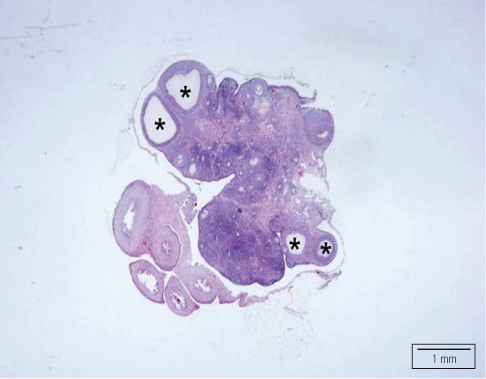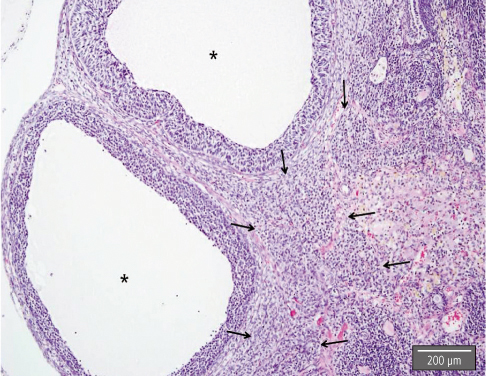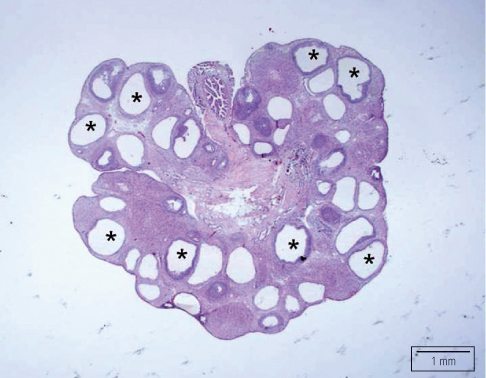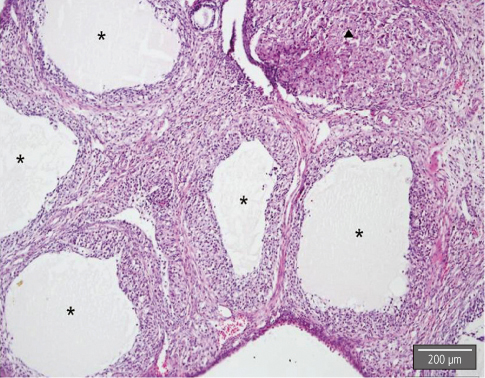Korean J Obstet Gynecol.
2011 Jun;54(6):294-299. 10.5468/KJOG.2011.54.6.294.
Histologic comparison of polycystic ovary syndrome induced by estradiol valerate and letrozole
- Affiliations
-
- 1Department of Pathology, Chosun University College of Medicine, Gwangju, Korea.
- 2Department of Oral Histology, Chosun University College of Dentistry, Gwangju, Korea.
- 3Department of Veterinary Surgery, Chonnam National University College of Veterinary Medicine, Gwangju, Korea. csbae210@chonnam.ac.kr
- 4Department of Medicine, Graduate School Chosun University, Gwangju, Korea.
- 5Department of Obstetrics and Gynecology, Korea University College of Medicine, Seoul, Korea.
- KMID: 2274037
- DOI: http://doi.org/10.5468/KJOG.2011.54.6.294
Abstract
OBJECTIVE
To compare ovarian morphology of the estradiol valerate (EV)- and the letrozole (LE)-induced polycystic ovary syndrome (PCOS) in rat models.
METHODS
EV were injected (IM) to 10 Sprague-Dawley rats and LE were administered (PO) to the other 10 Sprague-Dawley rats for 21 days. Sixty days after single injection of EV and 21 days after LE administration, the animals were sacrificed and the ovaries were sectioned, measured and analyzed histopathologically.
RESULTS
LE-treated group showed larger ovary bearing more abundant cystic follicles with luteinized theca cells. These findings were more similar to human PCOS ovarian morphology.
CONCLUSION
LE-induced PCOS model is recommended to conduct PCOS-related animal experiments.
MeSH Terms
Figure
Reference
-
1. Knochenhauer ES, Key TJ, Kahsar-Miller M, Waggoner W, Boots LR, Azziz R. Prevalence of the polycystic ovary syndrome in unselected black and white women of the southeastern United States: a prospective study. J Clin Endocrinol Metab. 1998. 83:3078–3082.2. Diamanti-Kandarakis E, Kouli CR, Bergiele AT, Filandra FA, Tsianateli TC, Spina GG, et al. A survey of the polycystic ovary syndrome in the Greek island of Lesbos: hormonal and metabolic profile. J Clin Endocrinol Metab. 1999. 84:4006–4011.3. Asunción M, Calvo RM, San Millán JL, Sancho J, Avila S, Escobar-Morreale HF. A prospective study of the prevalence of the polycystic ovary syndrome in unselected Caucasian women from Spain. J Clin Endocrinol Metab. 2000. 85:2434–2438.4. Moran C, Tena G, Moran S, Ruiz P, Reyna R, Duque X. Prevalence of polycystic ovary syndrome and related disorders in mexican women. Gynecol Obstet Invest. 2010. 69:274–280.5. Bai YH, Lim SC, Song CH, Bae CS, Jin CS, Choi BC, et al. Electro-acupuncture reverses nerve growth factor abundance in experimental polycystic ovaries in the rat. Gynecol Obstet Invest. 2004. 57:80–85.6. Lee JC, Pak SC, Lee SH, Lim SC, Bai YH, Jin CS, et al. The effect of herbal medicine on nerve growth factor in estradiol valerate-induced polycystic ovaries in rats. Am J Chin Med. 2003. 31:885–895.7. Jensen JT. Evaluation of a new estradiol oral contraceptive: estradiol valerate and dienogest. Expert Opin Pharmacother. 2010. 11:1147–1157.8. Zacharieva S, Kirilov G, Kalinov K, Shigarminova R, Nachev E, Orbetzova M, et al. Effect of different hormone replacement therapy regimens on circadian blood pressure profile and active renin in postmenopausal women. Gynecol Endocrinol. 2002. 16:461–467.9. Torrisi R, Bagnardi V, Rotmensz N, Scarano E, Iorfida M, Veronesi P, et al. Letrozole plus GnRH analogue as preoperative and adjuvant therapy in premenopausal women with ER positive locally advanced breast cancer. Breast Cancer Res Treat. 2011. 126:431–441.10. Iwata H. Neoadjuvant endocrine therapy for postmenopausal patients with hormone receptor-positive early breast cancer: a new concept. Breast Cancer. 2011. 18:92–97.11. Morales-Ledesma L, Linares R, Rosas G, Morán C, Chavira R, Cárdenas M, et al. Unilateral sectioning of the superior ovarian nerve of rats with polycystic ovarian syndrome restores ovulation in the innervated ovary. Reprod Biol Endocrinol. 2010. 8:99.12. Kafali H, Iriadam M, Ozardali I, Demir N. Letrozole-induced polycystic ovaries in the rat: a new model for cystic ovarian disease. Arch Med Res. 2004. 35:103–108.13. Rotterdam ESHRE/ASRM-Sponsored PCOS consensus workshop group. Revised 2003 consensus on diagnostic criteria and long-term health risks related to polycystic ovary syndrome (PCOS). Hum Reprod. 2004. 19:41–47.14. Jonard S, Robert Y, Cortet-Rudelli C, Pigny P, Decanter C, Dewailly D. Ultrasound examination of polycystic ovaries: is it worth counting the follicles? Hum Reprod. 2003. 18:598–603.15. Murphy MK, Hall JE, Adams JM, Lee H, Welt CK. Polycystic ovarian morphology in normal women does not predict the development of polycystic ovary syndrome. J Clin Endocrinol Metab. 2006. 91:3878–3884.16. Hassa H, Tanir HM, Yildiz Z. Comparison of clinical and laboratory characteristics of cases with polycystic ovarian syndrome based on Rotterdam's criteria and women whose only clinical signs are oligo/anovulation or hirsutism. Arch Gynecol Obstet. 2006. 274:227–232.17. Mortensen M, Rosenfield RL, Littlejohn E. Functional significance of polycystic-size ovaries in healthy adolescents. J Clin Endocrinol Metab. 2006. 91:3786–3790.18. Welt CK, Gudmundsson JA, Arason G, Adams J, Palsdottir H, Gudlaugsdottir G, et al. Characterizing discrete subsets of polycystic ovary syndrome as defined by the Rotterdam criteria: the impact of weight on phenotype and metabolic features. J Clin Endocrinol Metab. 2006. 91:4842–4848.19. Lanham MS, Lebovic DI, Domino SE. Contemporary medical therapy for polycystic ovary syndrome. Int J Gynaecol Obstet. 2006. 95:236–241.20. Young RH, Scully RE. Kraus FT, Damjanov I, Kaufman N, editors. Ovarian pathology in infertility. Pathology of reproductive failure. 1991. Baltimore: Williams and Wilkins;104–139.21. Homburg R. Polycystic ovary syndrome - from gynaecological curiosity to multisystem endocrinopathy. Hum Reprod. 1996. 11:29–39.
- Full Text Links
- Actions
-
Cited
- CITED
-
- Close
- Share
- Similar articles
-
- Stereological study of the effects of letrozole and estradiol valerate treatment on the ovary of rats
- Alteration of TGFB1, GDF9, and BMPR2 gene expression in preantral follicles of an estradiol valerate-induced polycystic ovary mouse model can lead to anovulation, polycystic morphology, obesity, and absence of hyperandrogenism
- Medical diagnosis and treatment of polycystic ovary syndrome
- Beneficial effects of Teucrium polium hydroalcoholic extract on letrozole-induced polycystic ovary syndrome in rat model
- The Efficacy of Letrozole in Women with a Poor Endometrial Response to Clomiphene Citrate





